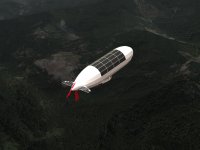paultrafalgar
10 kW
One way to miss the traffic jams:
http://www.treehugger.com/files/2009/02/sunseeker-2-solar-airplane-flying-over-europe.php
8)
http://www.treehugger.com/files/2009/02/sunseeker-2-solar-airplane-flying-over-europe.php
8)
lawsonuw said:Now do the same thing with a small blimp/dirigible and you'll never have to land! (well, except for food...)
Lawson

Lock said:lawsonuw said:Now do the same thing with a small blimp/dirigible and you'll never have to land! (well, except for food...)
Lawson
...something like this?
View attachment 1
AussieJester said:Now THATS very cool why don't we see more air ships they were all the rage in the 1980's then died out, big Brewery Company here Swan Brewery (once owned by the man that finaced the Austrlia II campaign in 1983 that successfully wtook the Americas Cup from you yanks for the first time in over 100 yearsin fact..Alan Bond..so he was later jailed for coporate fraud but thats another matter altogether hes a HERO
) he had a blimp that was always up and flying about, haven't seen one in yeeeeears. I guess the whole landing in high winds moving it about and the size of the hanger required would be a big factor?
KiM
lawsonuw said:The "never having to land" part of a solar airship should mitigate any issues with high wind landing and hangar space.
Lawson


spinningmagnets said:During WWII the east coast had two helium-filled dirigibles for anti-submarine patrol. The lower half of the craft in the center was the operations compartments. Although monoplanes had been invented for their lower drag and higher top speed, Biplanes launched from the dirigibles were used for their excellent fuel mileage and slow stall speed for deploying and retrieval.
A hook would be lowered into the air and the biplane pilot would fly a large top-ring onto the hook. If he missed, he would just circle around for another go. Once hooked, the plane was winched up into the hangar. The landing gear was unneccessary and had been completely removed to reduce weight.
spinningmagnets said:...
Sadly they were both destroyed in two separate hurricanes that they were unable to climb above or outrun.
...

spinningmagnets said:The Helios high-altitude solar-PV UAV uses electric-driven propellors to stay high above storms, so its do-able.
